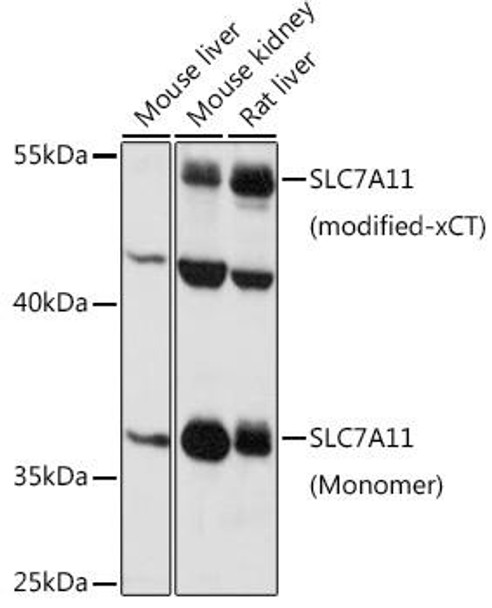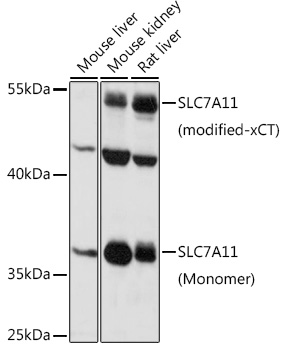Anti-SLC7A11 Antibody (CAB13685)
- SKU:
- CAB13685
- Product type:
- Antibody
- Reactivity:
- Mouse
- Rat
- Host Species:
- Rabbit
- Isotype:
- IgG
- Antibody Type:
- Polyclonal Antibody
- Research Area:
- Signal Transduction
Frequently bought together:
Description
| Antibody Name: | Anti-SLC7A11 Antibody |
| Antibody SKU: | CAB13685 |
| Antibody Size: | 20uL, 50uL, 100uL |
| Application: | WB |
| Reactivity: | Mouse, Rat |
| Host Species: | Rabbit |
| Immunogen: | A synthetic peptide corresponding to a sequence within amino acids 150-250 of human SLC7A11 (NP_055146.1). |
| Application: | WB |
| Recommended Dilution: | WB 1:500 - 1:2000 |
| Reactivity: | Mouse, Rat |
| Positive Samples: | Mouse liver, Mouse kidney, Rat liver |
| Immunogen: | A synthetic peptide corresponding to a sequence within amino acids 150-250 of human SLC7A11 (NP_055146.1). |
| Purification Method: | Affinity purification |
| Storage Buffer: | Store at -20°C. Avoid freeze / thaw cycles. Buffer: PBS with 0.02% sodium azide, 50% glycerol, pH7.3. |
| Isotype: | IgG |
| Sequence: | ILEP FFIQ CEIP ELAI KLIT AVGI TVVM VLNS MSVS WSAR IQIF LTFC KLTA ILII IVPG VMQL IKGQ TQNF KDAF SGRD SSIT RLPL AFYY GMYA YAGW F |
| Gene ID: | 23657 |
| Uniprot: | Q9UPY5 |
| Cellular Location: | Membrane, Multi-pass membrane protein |
| Calculated MW: | 55kDa |
| Observed MW: | 37kDa/55kDa |
| Synonyms: | SLC7A11, CCBR1, xCT |
| Background: | This gene encodes a member of a heteromeric, sodium-independent, anionic amino acid transport system that is highly specific for cysteine and glutamate. In this system, designated Xc(-), the anionic form of cysteine is transported in exchange for glutamate. This protein has been identified as the predominant mediator of Kaposi sarcoma-associated herpesvirus fusion and entry permissiveness into cells. Also, increased expression of this gene in primary gliomas (compared to normal brain tissue) was associated with increased glutamate secretion via the XCT channels, resulting in neuronal cell death. |
| UniProt Protein Function: | Sodium-independent, high-affinity exchange of anionic amino acids with high specificity for anionic form of cystine and glutamate. |
| NCBI Summary: | This gene encodes a member of a heteromeric, sodium-independent, anionic amino acid transport system that is highly specific for cysteine and glutamate. In this system, designated Xc(-), the anionic form of cysteine is transported in exchange for glutamate. This protein has been identified as the predominant mediator of Kaposi sarcoma-associated herpesvirus fusion and entry permissiveness into cells. Also, increased expression of this gene in primary gliomas (compared to normal brain tissue) was associated with increased glutamate secretion via the XCT channels, resulting in neuronal cell death. [provided by RefSeq, Sep 2011] |
| UniProt Code: | Q9UPY5 |
| NCBI GenInfo Identifier: | 7657683 |
| NCBI Gene ID: | 23657 |
| NCBI Accession: | NP_055146.1 |
| UniProt Secondary Accession: | Q9UPY5,A8K2U4, |
| UniProt Related Accession: | Q9UPY5 |
| Molecular Weight: | Observed: 40 kDa-45 kDaPredicted: 56 kDa |
| NCBI Full Name: | cystine/glutamate transporter |
| NCBI Synonym Full Names: | solute carrier family 7 member 11 |
| NCBI Official Symbol: | SLC7A11 |
| NCBI Official Synonym Symbols: | xCT; CCBR1 |
| NCBI Protein Information: | cystine/glutamate transporter |
| UniProt Protein Name: | Cystine/glutamate transporter |
| UniProt Synonym Protein Names: | Amino acid transport system xc-; Calcium channel blocker resistance protein CCBR1; Solute carrier family 7 member 11; xCT |
| Protein Family: | Protein XAP5 CIRCADIAN TIMEKEEPER |
| UniProt Gene Name: | SLC7A11 |









